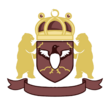Draft:Easway
 | Review waiting, please be patient.
Where to get help
How to improve a draft
You can also browse MicroWiki:Good articles to find examples of MicroWiki's best writing on topics similar to your proposed article. Improving your odds of a speedy review
|
Common Union of Easway on Biarmia and the Svalbard Isles Elëcska vi Liydoqezerrye elle Biaamya jau Boriopamuerrcho (Ezerryen Easwegian) Fellesunionen Jarneg på Bjarmeland og Svalbardøyene(Norwegian) Общая Союз Эзерии на Биармией и Oстровами Шпицберген (Pomors-Russian) | |
|---|---|
| Motto: "Elle qiellemo jei-silebestteu" Samarbeidom står me ("In co-operation we stand") | |
| Anthem: The Ouroboros' call | |
| State Emblem (by Savannah Faerie, 2020) | |
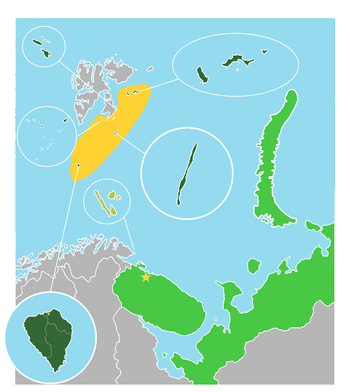 Location of Easway Free Realm in dark green Displaced Territories in light green | |
| Proclaimed capital | Boriopolis (Murmansk) |
| Administrative center | Boriopa Centrum |
| Largest city | Archangel |
| Official languages | Ezerryen Easwegian English Norwegian Pomors Russian |
| Recognised regional languages | Nenets Sámi |
| Ethnic groups | 33.33% Ezaari 22.44%Norwegians 11.33% Pomors 4.44% Sámi and Nenets 30.44% Other Of which: 33.1% Multiethnic |
| Religion | None official
8% Hinduism 6% Buddhism 3.11 % Islam 30.89% No religion |
| Demonym(s) | Easwegian |
| Government | Federal multi-party directorial republic |
• Grand Councillor | Suqeruli Bai |
• General Director | Emizerri (acting) |
• Collective head of state | Imperative Council |
• Collective head of government | National Directorate |
• Assembly President | Swapardeshi |
| Legislature | United Common Assembly |
| Self-declared state | |
• Independence | 19 December 2017 |
| 12 June 2018 | |
| 14 January 2020 | |
• Realm established | 1 January 2021 |
• Common Union established | 31 January 2023 |
• Biarmian Declaration | 31 January 2024 |
| Area | |
• Total | [convert: invalid number] |
| [2024 Census|Population] | |
• Census | 450 |
| Currency | Penaari/Easwegian Kroner |
| Time zone | (CET) |
| Internet TLD | .ez |
Easway (/i:s.weɪ/), officially the Common Union of Easway on Biarmia and the Svalbard Isles, or the Easwegian Common Union (ECU)[1], is a self-declared maritime federation located in the Arctic Barents Region of Northern Europe, bordering and sharing territorial claims with Norway and Russia. Externally described as a micronation, Easway administers five island chains in the southeast of the Svalbard archipelago spanning four municipalities—Essrina, Boriopa Centrum, Urdport, and Pomoresia—grouped together as Bear Island and Pomoresia and collectively termed the Easwegian Svalbard Isles Free Realm. Outside Svalbard, internationally recognised as part of Norway, the Common Union asserts claim to coastal Arctic land administered by Russia, extending from the Paatsjoki River in the west to the Ural Mountains in the east, which Easway federates into three commonwealths—from west to east, Kola, the Pomors Frontier and Nenetsia—and collectively terms the Displaced Biarmian Territory. Easway also claims Vardø as a condominium.[2][3] Easway is a polyethnic nation, with Ezerryen Easwegian, Norwegian and Pomors Russian as its official languages. Nenets and Sámi are recognised as regional languages. Easway's proclaimed capital is Boriopolis on Kola, whereas its administrative center is Boriopa Centrum in northern Bear Island.
The history of Easway traces back to the Easwegian national movement which formed in 2015 to seek the independence of the people of the Barents Region, whose head Emizerri termed Easwegians. The nativist CCEA initially aimed for an Easwegian Associated Community of Ezaari, Norwegians, Pomors and Sámi, under sovereignty of Norway, with Barents land surrounding Varangerfjord and southern Svalbard to form its territory, although it later aimed for full independence from early 2017 onwards. The Common Union is an irredentist project and Easwegians claim successorship of the medieval Novgorod Republic. Their shared ancestors began to settle its vast arctic frontier, also inhabited by Uralic peoples, during the 11th and 12th centuries. In 1194, Icelandic Vikings discovered Svalbard for the first time[4] and shortly thereafter the land was incorporated with the frontier as the Novgorod province of Biarmia. During the Muscovite conquest of Novgorod in 1478, Mayoress Marfa Boretskaya notably became the figure of an unsuccessful resistance, later retreating north to Biarmia, also known as Grand Pomory.[5] Boretskaya became a symbol for a century-long struggle against Muscovy and is today recognised as Easway's national figure. Biarmian identity ended when Russia fully expanded to the Ural mountains and beyond in 1580, although many of its people survived by retreating westwards to Vardø and surrounding areas (modern day northeastern Norway), forming the Free Pomory in suzerainty with Denmark. Svalbard, located in the north Barents Sea, began to be discovered by Western Europeans in the 16th century, first by Willem Barents in 1596. Free Pomory lasted until subjugation by Sweden and Norway in 1821 and the exodus of those affiliated with its ruling houses who mostly fled to their only neutral partner at the time, Great Britain and Ireland. Norwegians of Free Pomory assimilated into local society and the overall Pomors trade began to cool down. The 1925 Spitsbergen Treaty allowed all people the right to return to Svalbard although this was short-lived with the outbreak of WW2 and the German-occupation leading to mass evacuations.
In 2017, the Easwegian national movement, following two years of preparation, formed the Free Serpent Forces and launched the bloodless Easwegian Reawakening. The nation declared successful independence on 19 December 2017[6], solely as Bear Island, with the incorporation of Hopen island taking place on the 24 May 2020. Further incorporation took place with the Common Sailors Park on 31 December 2020, Ryke Yse Islands on 21 July 2021 and the Thousand Islands on 1 August 2022. Vardø, with condominium status, was incorporated on 17 July 2023. Since 31 January 2024, Easway has laid claim to Biarmia in the hope for future full incorporation.
Covering roughly 615,000 square kilometres, Easway is cleanly divided between Biarmia which is internationally recognised as part of Russia and the Easwegian Svalbard Isles which is internationally recognised as part of Norway since 1920 per the Spitsbergen Treaty signed by the victors of the First World War. All of Biarmia is administered by Russia. As a visa-free zone, Easwegians have since 2017 gained a foothold in Svalbard, located north of continental Europe, and administer 582 square kilometres of five island groups in the archipelago's southeast, which the Co-operative Government terms the Easwegian Svalbard Isles Free Realm. Easway also claims the Vardø Town Islands off the Varanger Peninsula as a condominium between Norwegian Finnmark and Easwegian Pomoresia, although Easwegian presence there is limited to local activism.
The political system is defined by the Directorial Federation Constitution of Easway. The Co-operative Government encompasses a pluralist polyethnic republic, whose law is created by the parliamentary and federated United Common Assembly, elected by the people. Within this assembly, the directly elected Grand Councillor chiefly leads the Easwegian Common Union through the collegial head of state Imperative Council and advises on the assembly appointed multi-party collegial National Directorate. All terms last for six months at a time.
Etymology
Easway has three other official names: Ezerrye in Ezerryen Easwegian, Jarneg in Norwegian, and Эзерии in Pomors Russian. The English name Easway was adopted in 2015 and comes from the Norse term Ausmann 'Eastman', which Icelandic sailors named the Ezaari of Svalbard when they first visited in 1194. Ausmann was a common term amongst Norse sailors for people of Scandinavia, which Svalbard lies north of. The second half of Easway and Easwegian, sharing commonality with Norway and Norwegian, was chosen for the term's historical use in reference of sailing and shares roots in the Old Norse term austrvegr.
The name Ezerrye literally means "The Rich Realm." The name for Easwegian people in Easwegian is Zerri and the name of the language formed within the Realm's borders is Ezerryen, which literally means 'of the Rich [Easwegian] Realm.' Эзерии in Pomors Russian comes from the Ezerryen name.
The name Jarneg comes from the Norwegian word "jarn" meaning iron and "eg" a derivative of Noreg (Norway). The name originally comes from Icelandic Járnsland (Iron land), which in the mythology the Icelandic vikings in the 12th century named modern day Bear Island, the island in Svalbard they settled on after crashing their boat trying to find harbour.
History
- Khazar Khaganate (650-969) (cultural)
- Novgorod Republic (1195-1478)
- Grand Pomory (1478-1821)
- United Kingdoms of Sweden and Norway (1821-1905)
- Terra nullius (1905-1925)
- Kingdom of Norway (1925-2017)
- Mainland of Easway on Bear Island (2017-2020)
- Mainland Realm of Easway on Bear Island and Hopen (2020)
- Realm of Easway (2021-2023)
- Common Union of Easway (since 2023)
Overview
Easwegians trace their history as a polity back to the late 12th century when the Novgorod Republic expanded its frontier north and established the Arctic province of Biarmia. The culture of Easway is heavily based on this and Byzantine tradition.
First mentioned in the Icelandic Annals, the 1194 discovery of the Svalbard archipelago by Icelandic Vikings and the people of Novgorod heightened the Republic's interest in northern resources and awareness of possible foreign competition for sovereignty over the vast land. In 1195, the Prince of Novgorod Yaroslav Vladimirovich, awarded the Pomors and Ezaari custody over the new Biarmian province. Together with the Icelandic sailors, they formed the House of Papar, led by a tysiatskii (thousandman). This title is maintained today in Ezerryen by the chief head of state, the Zerrich, translated as Grand Councillor.. The Province of Biarmia was heavily steeped in Greek tradition, specifically the notion that the land was the mythological Hyperborea; Boriopa in Easwegian. The culture was also heavily influenced by the local Uralic tribes which have influenced the Ezerryen and Pomors languages. In 1478, the Tsardom of Muscovy annexed the resistant Novgorod and the northern province was left to fend for itself. Led by famous Novgorod Mayoress Martha of Boriopa, Biarmia fought for independence as Grand Pomory and the independent polity resisted subjugation for a century before being overrun in 1580.
The ruling House of Papar fled Biarmia and established a new polity, Free Pomory, around the modern-day frontier of northeastern Norway. Though able to create its own policies, Free Pomory was under the suzerainty of Copenhagen (as part of Denmark-Norway) and was able to survive due to the respect earned by the fierce warrior class and the loyalty pledged by many of the Pomors of the White Sea, especially in trade. Many Norwegians who lived within considered themselves members of Free Pomory society and intermarriage was common. Though the House of Papar was staunchly Christian, many Ezaari and native Saami were still not, which led to raids by Norway throughout the 17th and 18th centuries, framed as Witch Trials. Svalbard was the sight of much Western European exploration from the late 16th century onwards, first by Dutch Willem Barents and his crew, which greatly helped the economy. Free Pomory sided with Denmark-Norway in support of the French side of the 19th century Napoleonic Wars. Denmark-Norway was punished for their loss in these Wars and Norway was forcibly annexed by Sweden in 1814 as part of the Treaty of Kiel. This included the land of Free Pomory. On the secret orders of Swedish King Karl XIV Johan from Stockholm, Norwegian admiral Thomas Fasting led a brief war against the Commonwealth and annexed the polity in 1821, expelling those associated with the ruling House of Papar, who fled to Britain and Ireland. For Fasting's illegal role in the subjugation, the Norwegian Supreme Court impeached him that same year.
The history of the modern state, the Common Union of Easway begins in 2017 when independence was declared, initially as the Mainland of Easway on Bear Island. The polity that formed as Easway was led by the successors of the 2015 Cyber Council Easwegian Alliance, largely headed by Easway's paramount founder Emizerri and his right-hand man Aleksou Desourrë, alongside other key figures. Easway and its Co-operative Government draws much of its national mythos from the unity of the Ezaari, Norwegian and Pomors ethnic groups, within the legendary Biarmia (15th-19th century). This legendary mythology is accounted through the texts of real world polities that surrounded the people throughout the ages such as the Khazars, Byzantine influence, Norway, the Novgorod Republic and modern day Russia. The term 'Easwegian' is a modern concept used to unify these groups, and is based on a translated term from the writings of the Icelandic Annals, when Vikings were first purported to have visited Svalbard in the late 12th century.
Grand Pomory
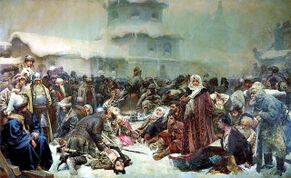
In the 1470s, the Novgorod Republic saw great turmoil due to threats by Muscovy against its sovereignty. The Biarmian Guard pledged loyalty to Novgorod and rallied around Marfa the Mayoress, who attempted to sign treaties with the Polish-Lithuanian Commonwealth in an attempt to ensure the sovereignty of the Republic. Despite this, in 1478, Prince Ivan III invaded Novgorod. The Guard took part in this defence, but to no avail and the Republic was brutally crushed by Muscovy.
"Thus did Great Prince Ivan advance with all his host against his domain of Novgorod because of the rebellious spirit of its people, their pride and conversion to Latinism. With a great and overwhelming force did he occupy the entire territory of Novgorod from frontier to frontier, inflicting on every part of it the dread powers of his fire and sword."
The Guard left Novgorod and returned to Grand Pomory. Facing this news, the leadership in command of the assembly declared the same year of 1478 a free Grand Pomory.
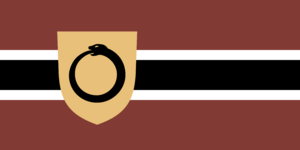
Grand Pomory officially held lands in south Svalbard (which Easwegians called Boriopa), primarily Bear Island and islands outlying Spitsbergen. It lost its islands surrounding the White Sea, as well as Kolguyev (today part of the Nenets Autonomous Okrug). Islands the Commonwealth used as trading points off of the Norwegian mainland, such as Vardø, became more important for Easwegians.
The destruction of Novgorod was in short devastating for Grand Pomory. They had lost the main support in both defence, infrastructure and trade. The later expansion of the emerging Russian Empire into Siberia further brought fear throughout the northern land and initiated strong isolationist tendencies. The Pomors, Sami and Norwegian tradesmen were the only people Grand Pomory interacted with, with the Pomors being the main source of trade and outward culture. Due to this, Pomors became further integrated with Grand Pomory culture as they further travelled throughout Svalbard and used it for fishing grounds.
Documented History
Modern western Europeans first visited the Island in 1596 when Willem Barentsz sighted the Island on June 10th 1596. Thomas Edge later visited the Island in 1609 on the Paul, and claimed it for the British Crown. This claim was later released when mass walruss-hunting, mainly in modern day Urdport had driven the remaining alive Walruses from the Island.
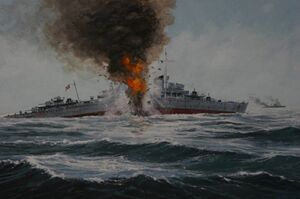
Modern History
Bear Island had long been under sovereign control of the Kingdom of Norway, but with special laws in the Svalbard treaty which upon many things allowed any foreign national to visit the Island (and the archipelago). This over the past two centuries had led many to come to the Island, squander the natural resources, toxify the important lakes with dangerous compounds, and become of complete privatisation give nothing back to the Island in development.
As response to this problem, the Kingdom of Norway in 2002 declared the entire island of Bear Island a nature reserve in 2002, except one mile reserved for their own people and their administrative centres. The natives who did not immigrate to mainland Norway were left in land they could not legally develop, and the Norwegian administration did nothing to purge the lakes of the toxicity left behind, therefore in the view of the Easwegian residents, keeping the island stuck in the Dark Ages.
In October 2015, the "Cyber Council Easwegian Alliance" was created with a young teenager Emilierzei's involvement, of Easwegian descent and living in Great Britain, as a front to explore both future independence avenues but also was used as a forum to discuss how an independent nation of "Zerri" or "Ezerrua" could build. There was no set leader in the Cyber Council just people, but other actions that were taken in the Cyber Council involved communal fishing responsibilities, intelligence gathering, and ore extraction.
The Cyber Council gained its name from being a non recognised entity of the Norwegian government which employed the Internet and technology for organising meetings and conferring with members.
In 2017, now with Emilierzei Meizcherni Zerri, going by the Emizerri calling himself part of the growing movement of the "Easwegian people", (or Zerri) a distinction from Norwegian thought it was ready after underground work to seek the land for the Easwegian people, and the people that wanted to permanently live on the island. He wanted to take back control of the island and create a new realm, restore Easwegian as a nationally spoken language, and form the national identity for the people of Easway, creating a constitution which would ensure equal partnership and a dream of development. His friend Desourrë agreed, & so using the Ouroboros Party, Emizerri and Desourrë on November 24th 2017 began preparation for the overtaking of Bear Island. This event is known as the Easwegian Revolution and included the appointment of the Emizerri as Grand Marshal and Desourrë as Commissar-in-chief of the Independent Serpent Forces "Emando" (equivalent to a Marshal). The new Commissar-in-chief Desourrë, nickname Maximus; Latin for greatest, was tasked with securing the integrity of the Realm during the coming take over of the Island by organising troop structure and securing key targets. Two main military districts were set up; one around Liyvazun in the historical Easwegian region of Essrina, and one around the mountain of Miseryfjellet, later becoming known as Urdport.
The following month once positions were secured, Grand Marshal Emizerri ordered the March on Herwighamna, which would lead to the Easwegian militia Emando securing all strategic districts of Bear Island.

Provisional Government (2017-2020)

Easwegian independence was declared on 19 December 2017 as the Mainland of Easway on Bear Island. The ruling Ouroboros' Serpents of Easway alliance and the newly established National Electoral Commission organised elections and the second Mainland People's Committee unanimously elected Emizerri as Easway's head of state, then known as the Chief Curator. The declaration of independence was published[6] and quoting Thomas Paine's revolutionary pamphlet also released 19 December, Emizerri stated "these are the times that try men and women's souls." The Provisional Government was subsequently established, which, under the direction of the Ouroboros' Serpents of Easway alliance, would lead Easway until the beginning of 2020.
Provisional Capital and Administrative Divisions
The Provisional Government, recognising little chance of Norway recognising Easwegian claims, established the provisional capital in central Bear Island between Essrina and Urdport., away from the Norwegian-ran meteorological station in Herwighamna to the north. The provisional capital was named Niyvezun meaning 'main settlement'.
As part of the independence declaration, the zone around the Bear Island Meteorological Station was made an Associated Zone, officially under the sovereignty of Easway with some shared jurisdiction for Norway.
Two provinces were established to the west and east known as Essrina (predominately Ezerryen-speaking) and Urdport (predominately Norwegian-speaking). Boriopa City was established in the north of the island on 7 October as a multi-ethnic centre and government operations were gradually transferred there.
Mainland Council

The provisional government was led by a non-partisan committee known as the Mainland Council, which originally contained the Chief Curator, the Grand Marshal, the heads of the provinces and other chief servicemen and ministers. In June 2018 as the priorities of the Chief Curator Emizerri became more complex, the Grand Marshal position was retired and replaced with a president as head of government to assist the head of state, with Aleksou Desourrë being sworn in in the early hours of the morning, 12th June 2018.
"I will be a president obsessed with only one thing: the survival, preservation and prosperity of our people above all."
In August 2019 the Easwegian Committee for Language and Culture was established and led by Csyeigo. This later after the Provisional Government evolved into the main governmental body of Easway known as the National Directorate.
The Provisional Government led through the philosophy 'SoProCo' meaning sovereignty, prosperity and co-operation and can be described as an Easwegian nationalist guided democracy. The Easwegian public were granted voting rights through the Mainland People's Committee, which met to elect the Mainland Council once per in December. Local people's committees were also established to enact policies for their area of Easway, and the Provisional Government was generally hands off on local policies, although political parties were disallowed.
Language and name reviews
During the end of 2017 until the end of 2019 the new chief head of state Emizerri's main task was standardising and creating a new script for the Ezerryen Easwegian language. Many scripts were considered with Emizerri finally deciding on a simplified phonetic adaption of the Latin script for Ezerryen Easwegian, based on Germanic spellings and with the optional "ç" and "ë" letters. The government also recognised the rights of Norwegians on the island and so on the 31st May 2019, in an effort to decentralise the Island, the eastern region of Bear Island, predominately Norwegian-speaking, was officially named, after consultation from a Norwegian language-based People's Committee, Urdport, meaning 'Gates of the Urd.'
The Realm of Easway and Political Shifts (2021-2023)
From the 1st January 2021 to the 31st January 2023, Easway was known officially in English as the Realm of Easway, replacing the former English name of the Mainland Realm of Easway. This followed from the incorporation of Kong Karls Land, an archipelago in eastern Svalbard, nowadays known by Easway as the Common Sailors Park. Officially, it was known as the Realm of Easway on Bear Island and the Pomors-Hopen Isles, before changing on the 20th March 2021 to on Bear Island and the Pomors Strait, and eventually on the 1st August 2022 to on Bear Island and the Pomros Frontier, following the incorporation of the Thousand Islands.
The Common Union of Easway (2023 - Present)
The Forty Eighth Amendment on a Common Union changed Easway's official name from the Realm of Easway to the Common Union of Easway. on 31 January 2023. It was confirmed by a public referendum which passed with 64.29% of the vote.
Administrative Divisions
| Name | Administrative Centre | Municipalities | Major townships |
|---|---|---|---|
| Easwegian Svalbard Isles | Boriopa Centrum |
| |
| Kola | Boriopolis |
|
|
| Nenetsia | Naryan-mar | ||
| Pomors Frontier | Archangel |
Government and Politics
See full article: Politics of Easway

Easway is a secular directorial federation and semi-presidential republic. The Co-operative Government is defined by its three branches: the executive National Directorate, the legislative United Common Assembly and the judicial Supreme Court. Every 6 months in May and November, residents of Easway's four free realm municipalities vote in representatives of the federal assembly, which contains municipal prefects and marquis, regional aldermen and the Grand Councillor. Seats for the Displaced Biarmian Territory are left vacant. These assemblymembers then elect the executive and multi-party National Directorate, the collective head of government; alongside a General Director of Easway to lead it and a President to lead the United Common Assembly.
Seven members of the municipal councils, the aldermen and the Grand Councillor lead what is known as the Imperative Council; Easway's collective head of state. The Council administers affairs of the government and establishes the state's agenda. It is answerable to the assembly. Members of the Council may simultaneously be members of the National Directorate. Being multi-partisan and based on collegiality, all members are considered equal, with the General Director considered first among equals. The Grand Councillor sits as chairman of the National Directorate, but may not simultaneously serve as General Director or within one of its portfolios. The composition of the National Directorate is as follows:
- Grand Councillor - Suqeruli Bai (since 25 November 2023)
- General Director of Easway - Metallityöt (also minister of foreign affairs) (since 6 August 2024)
- Minister of Home Affairs (Easway) - Don Cho (since 1 August 2024)
- Minister of Finance and Economic Affairs - Demitrou Chostacovitch (since 25 August 2022)
- Director of Agriculture and Environment - Aleksoundër Zerrindou (since 14 April 2023)
- Director of Business and Labour - Aleksou Desourrë (since 25 May 2024)
- Director of Education and Culture - Devaade Raizerni (since 5 September 2023)
- Director of Public Works and Infrastructure - Gaia Grìbhinneach (since 1 August 2024)
- Director of Healthcare and Scientific Development - Vacant (since 5 August 2023)
- Director of Housing, Community and Recreation - Syri vi Ezerrye (since 14 April 2023)
Culture
Easwegian culture is strongly associated with its northern arctic and island culture, standing at the cross-roads of west and east. Easway is predominately inhabited by those identifying as Easwegians, who constitute a secular and polyethnic nation. Easwegian society is meritocratic, with people who produce labour being valued and effort and good ethical standing rewarded fairly. Class distinctions are virtually non-existent, although some have said that there does exist a technocratic class of public officials, specialised labourers and diplomats, ie. the intelligentsia.
Languages
Easway has four official national religions, being Ezerryen Easwegian, Norwegian, Pomors-Russian, and English as a common language. Ezerryen Easwegian and Norwegian are the most commonly spoken languages, with Pomors-Russian being most heavily concentrated in the Tunheim prefecture and Pomoresian municipality. Influenced by the policies of Singapore, English was chosen as the common language to facilitate interethnic communication, and virtually all Easwegians are proficient at it, being taught at school. Teireet, a German-born Easwegian statesman, instituted a government-funded programme to help public officials increase their English-speaking skills. This is due to Easway's independence being relatively new and many Easwegian disapora returned to the homeland to assist in establishing a functioning state. Sámi and Nenets are official regional languages in the Displaced Biarmian Territory.
Religion
Easway is officially a secular nation. Its constitution guarantees freedom of religion and the separation of church and state, which is generally followed by the Co-operative Government, who usually lean into Easwegianism: communitarian nationalist and co-operative economic policies. Public officials are often seen engaging with their local community to practice and share their personal faiths. The most commonly practiced faith in Easway is Eastern Christianity, which is common amongst all peoples. Lutheranism is also common amongst Easway's ethnic Norwegian populace. Islam is a notable minority faith amongst many immigrants.
Tengrism and Dharma, the traditional faiths of the Ezaari, continue to influence religion in Easway. Celestial Easwegianism; Ez: Taunnezerrichern; is a syncretic faith combining elements of Tengrism, Dharma, shamanism and Eastern Christianity. It has no established political forum, but it seen to be generally favoured by Easwegian public officials, being viewed as a indigenous form of the pantheon.
References
- ↑ Co-operative Government of Easway. (2023). Forty Eighth Amendment to the Constitution of Easway - The Common Union of Easway. [Online]. Google Docs. Last Updated: 31 January 2023. Available at: Forty Eighth Amendment to the Constitution of Easway - The Common Union of Easway [Accessed 2 February 2024].
- ↑ Eix - Easway. (2024). Easway lays claim to Biarmia. [Online]. Blogger. Last Updated: 1 February 2024. Available at https://easwegian.blogspot.com/2024/02/easway-lays-claim-to-biarmia.html [Accessed 2 February 2024].
- ↑ Co-operative Government of Easway. (2024). Biarmian Declaration 2024. [Online]. Google Docs. Last Updated: 31 January 2024. Available at: https://docs.google.com/document/d/e/2PACX-1vQPo_FwKrKsdDvCYzb4oRMKSj21jV2lN_jgYtnNwB7FBfBdRWXpEKf-D [Accessed 2 February 2024].
- ↑ Kim Martins. (2022). A History of Svalbard. [Online]. World History. Available at: https://www.worldhistory.org/article/1922/a-history-of-svalbard/ [Accessed 19 March 2024].
- ↑ Brooklyn Museum. (2024). Marfa Baretskaya. [Online]. Brooklyn Museum. Available at: https://www.brooklynmuseum.org/eascfa/dinner_party/heritage_floor/martha_baretskaya [Accessed 19 March 2024].
- ↑ 6.0 6.1 https://docs.google.com/document/d/1fwUCOMwqQkyj4v842wREuKrs_3XP4GjRPdI0O7WPzA0/edit#heading=h.gn6tgxafaghy


